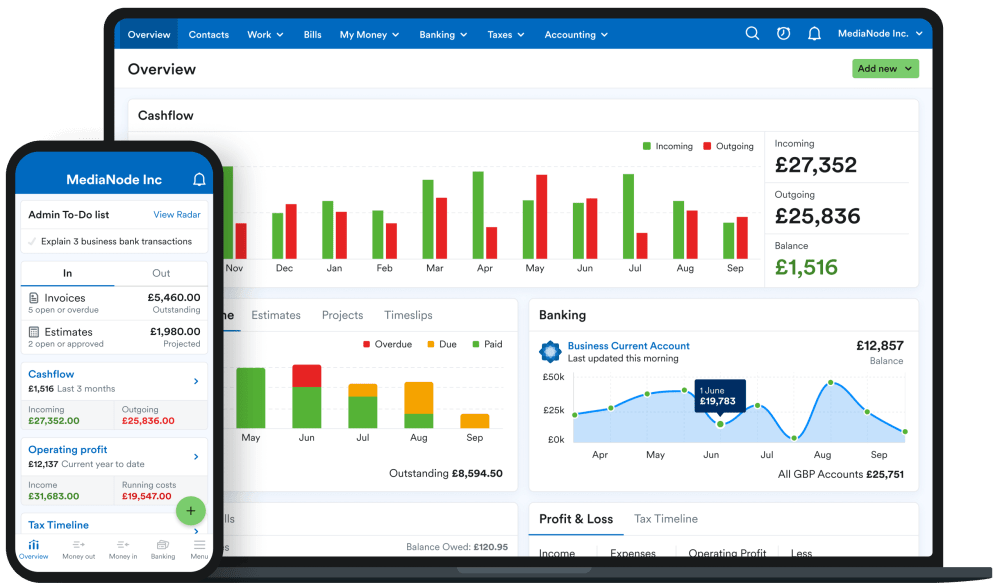The table above shows 2025/26 Income Tax rates for taxpayers in England, Wales and Northern Ireland who have a standard Personal Allowance of £12,570.
Income Tax: what you need to know
You pay Income Tax on most income you receive in a tax year above your Personal Allowance. You can find out more about Income Tax on our accounting glossary.
Note: Income from dividends is one example of income that’s taxed at a different rate.
The Scottish rate of Income Tax
Taxpayers in Scotland pay Income Tax in a different way to the rest of the UK. You can find out more about the Scottish rate of Income Tax on our dedicated page.
Example: how to calculate your Income Tax
A freelance copywriter is registered with HMRC as a sole trader. Every year they must pay Income Tax on profits above their Personal Allowance. They need to know three things in order to work out how much to pay:
- Their profit: £25,070
- The Personal Allowance that applies to them: £12,570
- The Income Tax rate their profit is subject to: in this example, the 20% basic rate
They deduct their Personal Allowance from their profit to work out their taxable income:
£25,070 - £12,570 = £12,500 taxable income
They then multiply their taxable income by the applicable Income Tax rate (20%) to work out the tax they are due to pay:
£12,500 x 20% = £2,500 to pay to HMRC in Income Tax
How to pay Income Tax
If you already pay tax through PAYE and owe less than £3,000 in total, HMRC can automatically take what you owe through your tax code. This will be taken from your salary or pension in equal instalments over 12 months. To be eligible to pay your Income Tax bill this way you must have completed your paper tax return before 31st October or your online tax return by 31st December. If you meet all three requirements but do not wish to pay in this way you should notify HMRC.
If you’re self-employed, Income Tax is calculated annually on your Self Assessment tax return. The total amount of Income Tax due following completion of your return can be paid in the following ways:
| Online or telephone banking (Faster Payments) | Same or next day |
| CHAPS | Same day |
| Bacs | Three working days |
| Debit card | Same or next day |
| Business credit card (1.5% charge, personal credit cards are no longer accepted) | Same or next day |
| Cheque through the post | Three working days |
| Existing Direct Debit | Three working days |
| New Direct Debit | Five working days |
| PAYE tax code | N/A |
| At your bank or building society | Same or next day |
Online or telephone banking: If you’re paying by online or telephone banking (Faster Payments, CHAPS or Bacs), details for the HMRC bank account you should pay your tax bill into on the government’s website.
Debit card or business credit card: If you’re paying by debit or credit card you can do so by following the links from your HMRC online account.
Cheque: You can pay your Income Tax bill with a cheque made payable to ‘HM Revenue and Customs only’ followed by your Unique Taxpayer Reference (UTR) number. It should be posted along with your paying-in slip to HMRC, Direct, BX5 5BD – no street name, city name or PO Box is required.
Direct Debit: You can set up a Direct Debit from your HMRC online account. The first time you set up a Direct Debit for Self Assessment allow at least five working days before you submit your return to ensure the payment is taken from your account in time. Thereafter allow for at least three days. Note that you have to set up a new direct debit every time you wish to make a payment and that payment on account requires a separate Direct Debit.
At your bank or building society: You can only pay your income tax bill at your bank or building society if you still get paper statements from HMRC and have the paying-in slip they sent to you in the post. Payments can be made by cash or cheque made payable to ‘HM Revenue and Customs only’ followed by your Unique Taxpayer Reference (UTR), followed by the letter ‘K’.
Previous Income Tax bands and rates
| 2025-26 | |
|---|---|
| Basic rate | 20% |
| Higher rate | 40% |
| Additional rate | 45% | 2024-25 |
| Basic rate | 20% |
| Higher rate | 40% |
| Additional rate | 45% | 2023-24 |
| Basic rate | 20% |
| Higher rate | 40% |
| Additional rate | 45% | 2022-23 |
| Basic rate | 20% |
| Higher rate | 40% |
| Additional rate | 45% | 2021-22 |
| Basic rate | 20% |
| Higher rate | 40% |
| Additional rate | 45% |
Note: All taxable income is defined as gross income less any allowances (such as the Personal Allowance) and reliefs available to the taxpayer.
